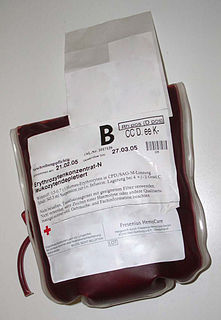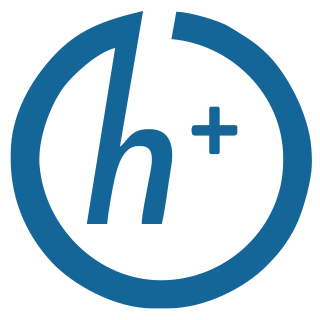Hematology is the branch of medicine concerned with the study of the cause, prognosis, treatment, and prevention of diseases related to blood. It involves treating diseases that affect the production of blood and its components, such as blood cells, hemoglobin, blood proteins, bone marrow, platelets, blood vessels, spleen, and the mechanism of coagulation. Such diseases might include hemophilia, blood clots (thrombus), other bleeding disorders, and blood cancers such as leukemia, multiple myeloma, and lymphoma. The laboratory analysis of blood is frequently performed by a medical technologist or medical laboratory scientist.

Blood transfusion is the process of transferring blood products into one's circulation intravenously. Transfusions are used for various medical conditions to replace lost components of the blood. Early transfusions used whole blood, but modern medical practice commonly uses only components of the blood, such as red blood cells, white blood cells, plasma, clotting factors, and platelets.
Transfusion medicine is the branch of medicine that encompasses all aspects of the transfusion of blood and blood components including aspects related to hemovigilance. It includes issues of blood donation, immunohematology and other laboratory testing for transfusion-transmitted diseases, management and monitoring of clinical transfusion practices, patient blood management, therapeutic apheresis, stem cell collections, cellular therapy, and coagulation. Laboratory management and understanding of state and federal regulations related to blood products are also a large part of the field.
A blood bank is a center where blood gathered as a result of blood donation is stored and preserved for later use in blood transfusion. The term "blood bank" typically refers to a division of a hospital where the storage of blood product occurs and where proper testing is performed. However, it sometimes refers to a collection center, and some hospitals also perform collection. Blood banking includes tasks related to blood collection, processing, testing, separation, and storage.
Leukoreduction is the removal of white blood cells from the blood or blood components supplied for blood transfusion. After the removal of the leukocytes, the blood product is said to be leukoreduced.

Russian cosmism is a philosophical and cultural movement that emerged in Russia at the turn of the 19th century, and again, at the beginning of the 20th century. At the beginning of the 20th century, there was a burst of scientific investigation into interplanetary travel, largely driven by fiction writers such as Jules Verne and H. G. Wells as well as philosophical movements like the Russian cosmism.

Jean-Baptiste-Gabriel-Joachim Dausset was a French immunologist born in Toulouse, France. Dausset received the Nobel Prize in Physiology or Medicine in 1980 along with Baruj Benacerraf and George Davis Snell for their discovery and characterisation of the genes making the major histocompatibility complex. Using the money from his Nobel Prize and a grant from the French Television, Dausset founded the Human Polymorphism Study Center (CEPH) in 1984, which was later renamed the Foundation Jean Dausset-CEPH in his honour. He married Rose Mayoral in 1963, with whom he had two children, Henri and Irène. Jean Dausset died on June 6, 2009 in Majorca, Spain, at the age of 92.
Faculty of Medicine, Dentistry and Health Sciences of the University of Melbourne has the largest number of post-graduate enrolments in the University of Melbourne and also hosts the most school departments and centres of all University of Melbourne Faculties, consisting of 52 faculty sub-organisations. In 2021, Melbourne Medical School was ranked 25th in the world and second in Australia in the 2021 QS Subject Rankings.

Harvey James Alter is an American medical researcher, virologist, physician and Nobel Prize laureate, who is best known for his work that led to the discovery of the hepatitis C virus. Alter is the former chief of the infectious disease section and the associate director for research of the Department of Transfusion Medicine at the Warren Grant Magnuson Clinical Center in the National Institutes of Health (NIH) in Bethesda, Maryland. In the mid-1970s, Alter and his research team demonstrated that most post-transfusion hepatitis cases were not due to hepatitis A or hepatitis B viruses. Working independently, Alter and Edward Tabor, a scientist at the U.S. Food and Drug Administration, proved through transmission studies in chimpanzees that a new form of hepatitis, initially called "non-A, non-B hepatitis" caused the infections, and that the causative agent was probably a virus. This work eventually led to the discovery of the hepatitis C virus in 1988, for which he shared the Nobel Prize in Physiology or Medicine in 2020 along with Michael Houghton and Charles M. Rice.
Immunohematology is a branch of hematology and transfusion medicine which studies antigen-antibody reactions and analogous phenomena as they relate to the pathogenesis and clinical manifestations of blood disorders. A person employed in this field is referred to as an immunohematologist. Their day-to-day duties include blood typing, cross-matching and antibody identification.
Louis Klein Diamond was an American pediatrician, known as the "father of pediatric hematology."
Eloise "Elo" R. Giblett was a pioneering genetic scientist and hematologist who discovered the first recognized immunodeficiency disease, adenosine deaminase deficiency. Giblett was a Professor of Medicine at the University of Washington in Seattle and Executive Director of the Puget Sound Blood Center in Seattle. The author of over 200 research papers, she also wrote an esteemed textbook on genetic markers, Genetic Markers in Human Blood, published in 1969. She was elected to the National Academy of Sciences in 1980.

Alexander Aleksandrovich Bogdanov, born Alexander Malinovsky, was a Russian and later Soviet physician, philosopher, science fiction writer, and Bolshevik revolutionary.

A bacteriologist is a microbiologist or a professional trained in bacteriology, a subdivision of microbiology. The duties of a bacteriologist include prevention, diagnosis and prognosis of diseases, as well as health care, and they may carry out various functions such as epidemiological surveillance, quality auditing with biotechnology development, basic research, management and teaching related to the career, scientist management, laboratory coordination and blood banks.
Jeane Porter Hester is a physician known for her work in cancer research and therapy. She was a Professor of Medicine, Chief of Supportive Therapy, and Chief of Leukapheresis at University of Texas MD Anderson Cancer Center in Houston, Texas, and was one of the developers of IBM 2997, the computerized blood cell separator. She was inducted into the Texas Women's Hall of Fame in 1984 and the Oklahoma Hall of Fame in 1987.
Mujibur Rahman was a Bangladeshi medical scientist. He established the first blood transfusion center at the Institute of Post Graduate Medicine and Research. He was awarded Ekushey Padak in 2014 by the Government of Bangladesh for his contribution to social service.
Olga Aleinikova — is a pediatric-oncohematologist, PhD, Doctor of Medical Science (1999), Professor (2003), Corresponding Member of the National Academy of Sciences of Belarus, Director of State Institution "Belarusian Research Center for Pediatric Oncology, Hematology and Immunology".
Jyoti Bhusan Chatterjea (1919–1972) was an Indian hematologist, medical academic and the director of Calcutta School of Tropical Medicine, He was known for his hematological and clinical studies of Hemoglobin E/β-thalassaemia and was an elected fellow of the National Academy of Medical Sciences, and the Indian National Science Academy. The Council of Scientific and Industrial Research, the apex agency of the Government of India for scientific research, awarded him the Shanti Swarup Bhatnagar Prize for Science and Technology, one of the highest Indian science awards for his contributions to Medical Sciences in 1966.
Young blood transfusion refers to transfusing blood specifically from a young person into an older one with the intention of creating a health benefit. The scientific community currently views the practice as essentially pseudoscientific, with comparisons to snake oil. There are also concerns of harm. The U.S. Food and Drug Administration, in 2019, cautioned "consumers against receiving young donor plasma infusions" stating that they are an "unproven treatment".

Musa Mirmammad oglu Abdullayev (27 November 1927, Masallı district, Azerbaijan SSR, USSR — 8 August 1979, Baku, Azerbaijan SSR, USSR) — Prominent hematologist of Azerbaijan, doctor of medicine, professor, philologist-translator. He was one of the eight members of the anti-Soviet nationalist student-youth political organization "Lightning" (İldırım), formed for the independence of Azerbaijan within 1942-1944.






